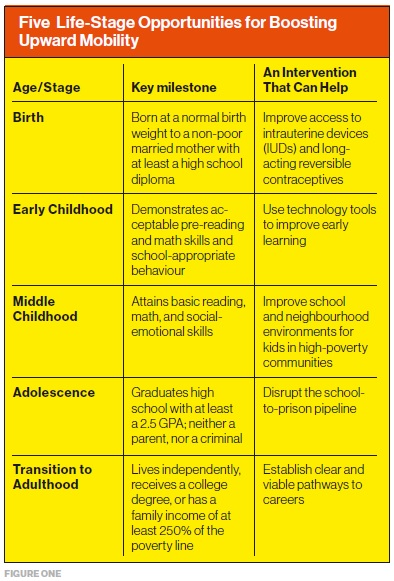
THE AMERICAN DREAM is not unique to America. Parents the world over harbour the hope that if their children work hard and build their skills, they can climb the income ladder and attain a higher standard of living. However, the odds that children will rise above their life’s station are more promising in many industrialized nations than they are in the U.S.: According to the Economic Policy Institute, Canada, Denmark, Norway, Finland and Australia offer the greatest opportunities for upward mobility. Meanwhile, the UK and the U.S. lag behind, just a couple of notches above countries with much smaller economies like Slovenia and Chile.
In their 2016 study, “The Fading American Dream,” Stanford Economist Raj Chetty et al. revealed that the probability of children earning more than their parents has been declining for more than 70 years. What’s more, according to the Pew Charitable Trusts’ Economic Mobility Project, seven out of 10 Americans who are born to parents in the bottom 40 per cent of the income scale will never make it to the middle class.
Stasis at the bottom of the income ladder has implications for everyone — not just those struggling to improve their lot. A strong middle class bolsters economic growth and stability in myriad ways. When families invest in children and companies invest in workers, they lift the population as a whole, incubate future generations of entrepreneurs and strengthen institutions. Without these investments, pipelines for growth and stability are compromised.
Putting Kids on an Upward Path
The Brookings Institution’s Social Genome Project shows that, if they are to improve their chances at upward mobility, children and young people must surpass a series of milestones as they grow. These range from being born to parents who are financially prepared to raise them to attaining a college degree or a family
income of $45,000 by their late 20s.
The project followed the lives of children from 1986 through 2010 and used its Social Genome Model (SGM) to predict where those children will land on the income ladder by age 40. The SGM allows analysts to examine how circumstances and actions at certain life stages echo through a person’s life — and either help or hinder future success. Today, just 17 per cent of low-income children meet every benchmark; but for those who do, their chances of becoming ‘middle class by middle age’ are almost as high as their better-off peers.
When employers evaluate candidates based on their competencies rather than their pedigrees, the talent pool gets a lot bigger.
Drawing from a year-long research effort, we have identified five opportunities where $1 billion of targeted private funding would have a chance to provide low-income individuals with an equal opportunity to improve their life trajectories. We will discuss each in turn, categorized by stage of life.
1. BIRTH: Improve Access to Contraceptives
Unintended pregnancies — those that are either unwanted or ill-timed — can lead to inter-generational cycles of poverty. Often, these pregnancies occur before the parents have completed their educations. Unplanned infants are more likely than other babies to have low birth weights, according to the Guttmacher Institute, and mothers in these circumstances are twice as likely to suffer from postpartum depression, which may lead them to drop out of high school or college.
Here’s the good news: From 2008 to 2011, unintended pregnancies dropped by 18 per cent in the U.S., reaching their lowest level in decades. Thanks in part to popular TV shows like MTV’s 16 and Pregnant and Teen Mom, interest in contraception is high.
Today, there are far more effective options than were once available — and with the expansion of public healthcare, many of them are available for free. Long-acting reversible contraceptive (LARC) methods — specifically, intrauterine devices (IUDs) and hormonal implants — require almost no daily effort, last for three to 10 years, and have less than a one per cent failure rate. However, less than half of low-income women are able to access any sort of family planning services from publicly-funded clinics.
With access and information, everything changes. In 2009, the state of Colorado offered 30,000 free LARC devices to women. Within four years, birth rates among teens and 20- to 24-year-old women dropped precipitously. Medicaid also avoided nearly $79 million in birth-related costs, making the initiative’s return on investment $5.85 for every dollar spent. Colorado illustrates that when clinics increase access to LARCs, unintended pregnancy becomes an almost entirely solvable problem.
ROI ON $1 BILLION: Applying the ‘Colorado effect’ would potentially result in up to 124,000 more properly-timed pregnancies. Using SGM’s estimate of increased lifetime earnings for the resulting babies, the calculated return is between $3.2 billion and $6.4 billion in total increased earnings for these children.
2. EARLY CHILDHOOD: Use Technology to Improve Early Learning
Last September, when children across the country entered kindergarten, more than one million of them weren’t ready to be there. Some lacked the cognitive skills required to do the work; others hadn’t developed the emotional maturity that would help them make it through long hours at school. Even more failed to meet the requisite health indicators (such as physical well-being and age-appropriate motor skills) to participate effectively in classes. These kids will likely struggle to overcome their limitations in kindergarten and beyond.
Experts now have a better understanding of how early development and school readiness influences a child’s progression. The Brookings Institution’s Centre on Children and Families reports that 82 per cent of children who enter kindergarten ‘developmentally ready’ will master basic skills by the third grade — an important indicator of continued success in middle school and high school.
Research shows that a child’s development is significantly influenced by life experiences—especially interactions with adults. By equipping parents and other caregivers with the right tools, we can foster development during the critical birth-to-kindergarten years. This is where digital technology — in the form of apps and computer programs — comes into play. For starters, tech tools can help parents and caregivers assess children for kindergarten-readiness and link them with the right services to get them ready for school. For example, there are ‘nudge technologies’ like the text4baby app, which sends new moms free text messages with personalized health and developmental information from birth through the baby’s first year. Mothers can set up reminders for doctor’s appointments and receive messages that describe baby’s key developmental milestones.
Then there’s the Waterford Institute’s UPSTART, a computer program that aims to close the kindergarten-readiness gap for four-year olds. Children, and importantly, their parents or caregivers, spend 15 minutes a day using the software, which uses songs and games to teach things like the alphabet, spelling and counting. A study in Utah showed that children who used the program for one year saw “lasting positive results” on standardized tests.
ROI ON $1 BILLION: If approximately 350,000 to 700,000 more children enter kindergarten with a greater capacity to learn, we estimate their cumulative lifetime earnings will increase by $5.5 billion to $11 billion.
3. MIDDLE CHILDHOOD: Improve Schools and Neighbourhoods in High-Poverty Areas
Where we are born has a lot to do with our lot in life. For instance, according to research from the Equality of Opportunity Project, children born in Salt Lake City, Utah and Pittsburgh, Pennsylvania have a dramatically better shot of achieving a better economic life than those born in Atlanta and Charlotte.
In 2010, more than 77 million people lived in concentrated poverty neighborhoods — areas where at least 20 percent of the residents live below the federal poverty level. One way to improve their chances of becoming upwardly mobile is to give families with children the chance to move to economically-diverse neighborhoods.
Consider Baltimore, Maryland, where a child who grows up in a low-income family goes on to earn less than children growing up in any of the 100 largest U.S. counties. In response to the challenges they saw, public officials and community leaders in Baltimore developed a promising program for moving people up and out of poverty. Since 2003, the Baltimore Housing Mobility Program has moved roughly 3,200 African American families out of highly-segregated neighbourhoods into low-poverty, racially- mixed neighbourhoods with low crime rates, high-quality schools and employment centres.
The Baltimore program is modeled after the 1990’s Moving to Opportunity for Fair Housing (MTO) experiment, which randomly selected families living in high-poverty housing projects in five U.S. cities to receive housing counseling and vouchers. Kids who moved when they were 13 or younger went on to earn incomes nearly one-third higher than their peers who stayed behind. At the same time, housing advocates are working to create opportunities for people to better their own blighted communities — by improving housing, housing policies, and social services — even as they help people move to opportunity.
ROI ON $1 BILLION: Providing housing vouchers to the families of 45,000 to 85,000 children will lead to potential lifetime family-earnings returns of between $4.5 billion and $8.5 billion, according to our estimates.
4. ADOLESCENCE: Decrease Rates of Incarceration
The U.S. is home to five per cent of the world’s population, yet it houses roughly 22 per cent of its prisoners. Over-criminalization has become a nationwide pattern that affects young people — and disproportionately, African Americans — in multiple ways. Children with at least one incarcerated parent are more likely to have lower family income and increased difficulty in school, both of which will affect their ability to climb the ladder to the middle class.
It’s not just parents who are crowding jails. Overly-punitive measures are funneling children — especially black children — into the school-to-prison pipeline. Given that research shows that any interaction with the criminal justice system produces negative outcomes for individuals, it follows that preventing brushes with the law is critical for decreasing over-criminalization.
School is a natural starting place. To combat the over-incarceration of students, several states are reconsidering zerotolerance policies that suspend or expel students for single infractions. For example, Ohio—having seen how zero-tolerance policies have contributed to economic and racial disparities—is promoting social and emotional learning and building student support teams to respond early to disruptive behaviour.
Another notable effort is the Safety + Justice Challenge’s work to support alternatives to jailing people who are neither a threat to the public nor a flight risk. Backed by the MacArthur Foundation, Safety + Justice is partnering with 40 jurisdictions to demonstrate alternatives to ‘incarceration as usual’ practices and create models for reducing the unnecessary use of jail. In Texas’ Harris County, which includes one of the nation’s largest detention facilities, officials are using a $2 million Safety + Justice grant to expand pre-trial diversion programs and to reimagine a system that makes it easier for defendants to gain release without posting bail. The goal is to safely cut the county’s jail population by 21 per cent within three years.
ROI ON $1 BILLION: If between 185,000 and 375,000 individuals avoid criminal convictions, we estimate that the resulting increase in their lifetime earnings will be between $4.3 billion and $8.6 billion.
5. TRANSITION TO ADULTHOOD: Establish Clear and Viable Pathways to Careers
An estimated 5.5 million 16- to 24-year-olds in the U.S. are neither in school nor working. These young people have been called ‘opportunity youth’ for their potential value to communities and the economy. Half have been disconnected from work and school since the age of 16.
Meanwhile, nearly six million entry-level jobs that are suitable for young people — including those who lack a college degree — are being created across a range of industries. And labour experts estimate that during this decade, the economy will generate 25 million openings for middle-skills jobs in computer technology,
nursing and other fields that require more technical education than high school, but less than a four-year college degree.
Key to matching opportunity youth with pathways to careers is to focus on the skills and aptitudes that are needed to do a given job. While college degrees will always be desirable, companies that maintain them as prerequisites for jobs potentially screen out unemployed youth who could do the work, if only they were given a chance.
When employer evaluate candidates based on their competencies rather than their pedigrees, the talent pool gets a lot bigger. New Mexico-based Innovate+Educate found that while just one percent of the state’s unemployed young adults met criteria for jobs that required a college degree, 33 per cent were qualified when measured by sheer skill.
CVS Health is one company at the forefront of the shift to skills-based hiring. The pharmacy chain hires 1,000 entry-level workers per week to keep its more than 9,600 retail locations fully staffed. Working with Jewish Vocational Services and other organizations, CVS’s workforce-development team reaches deep into communities to find overlooked talent. Their efforts include a training store at the Greater Lowell Technical High School in the Tyngsborough, Massachusetts area, where three-quarters of the students are low income.
In addition, partnerships between high schools, colleges and local corporations are expanding to entire regions, such as the National Academy Foundation’s NAFTrack career program, which thus far has secured 13 major corporate partners, including JP Morgan Chase, Hewlett-Packard, Verizon and Lenovo.
These endeavours represent a growing set of exemplars of effective career pathways that are ripe for replication.
ROI ON $1 BILLION: If between 66,000 and 132,000 individuals earn a credential with labour market value — such as a certificate for completing a skills-based course — we estimate the overall series of investments will lead to a cumulative increase in their lifetime income of $7.3 billion to $14.7 billion.

In closing
Reversing a half-century of declining economic mobility won’t happen overnight. And while the interventions we’ve identified have the potential to help millions up the economic ladder, even that number is dwarfed by the scale of the need.
That said, we are now armed with a deeper understanding of what young people must do to get on an upward trajectory, and we are poised to intervene in tangible ways. Each of the interventions described herein are built on innovations that are already delivering results. With $1 billion of capital behind them, they might gain more traction against seemingly-intractable challenges — and point the way for both corporations and public agencies to do much more. Restoring economic mobility is far too essential not to bet on it. But we can be smart about it and proceed in ways that are backed by data and evidence — so that people who are crowded in the economy’s basement stand a fighting chance of attaining the dream of a better life.
Debby Bielak is a partner in The Bridgespan Group’s San Francisco office.
Devin Murphy is a manager in the same office. They are co-authors, with Jim Shelton, head of the Chan Zuckerberg Initiative’s education division, of the report,
Billion Dollar Bets to Create Economic Opportunity for Every American, which can be downloaded online. To learn how they crunched the ROI numbers, see their
Stanford Social Innovation Review article, “What’s the Return on Investment on Reviving the American Dream?”, available online.
This article originally appeared in The Inequality Issue (Fall 2017) of Rotman Management. The magazine offers the latest thinking on leadership and innovation and is published three times a year.
Share this article: